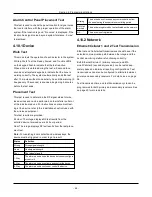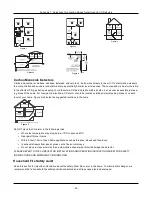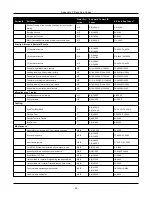
Appendix 1: Guidelines for Locating Smoke Detectors and CO Detectors
1.
Are all electrical appliances and outlets in a safe condition? Check for frayed cords, overloaded lighting circuits, etc.
If you are uncertain about the condition of your electrical appliances or household service, have a professional eval-
uate these units.
2.
Are all flammable liquids stored safely in closed containers in a well-ventilated cool area? Cleaning with flammable
liquids should be avoided.
3.
Are fire-hazardous materials (e.g., matches) well out of reach of children?
4.
Are furnaces and wood-burning appliances properly installed, clean and in good working order? Have a pro-
fessional evaluate these appliances.
Fire Escape Planning
There is often very little time between the detection of a fire and the time it becomes deadly. It is thus very important that a
family escape plan be developed and rehearsed.
1.
Every family member should participate in developing the escape plan.
2.
Study the possible escape routes from each location within the house. Since many fires occur at night, special atten-
tion should be given to the escape routes from sleeping quarters.
3.
Escape from a bedroom must be possible without opening the interior door.
Consider the following when making your escape plans:
l
Make sure that all border doors and windows are easily opened. Ensure that they are not painted shut, and that their
locking mechanisms operate smoothly.
l
If opening or using the exit is too difficult for children, the elderly or handicapped, plans for rescue should be
developed. This includes making sure that those who are to perform the rescue can promptly hear the fire warning
signal.
l
If the exit is above the ground level, an approved fire ladder or rope should be provided as well as training in its use.
l
Exits on the ground level should be kept clear. Be sure to remove snow from exterior patio doors in winter; outdoor
furniture or equipment should not block exits.
l
Each person should know the predetermined assembly point where everyone can be accounted for (e.g., across the
street or at a neighbour’s house). Once everyone is out of the building, call the fire department.
l
A good plan emphasizes quick escape. Do not investigate or attempt to fight the fire, and do not gather belongings
as this can waste valuable time. Once outside, do not re-enter the house. Wait for the fire department.
l
Write the fire escape plan down and rehearse it frequently so that should an emergency arise, everyone will know
what to do. Revise the plan as conditions change, such as the number of people in the home, or if there are changes
to the building’s construction.
l
Make sure your fire warning system is operational by conducting weekly tests. If you are unsure about system oper-
ation, contact your installer.
l
We recommend that you contact your local fire department and request further information on fire safety and escape
planning. If available, have your local fire prevention officer conduct an in-house fire safety inspection.
- 50 -










































